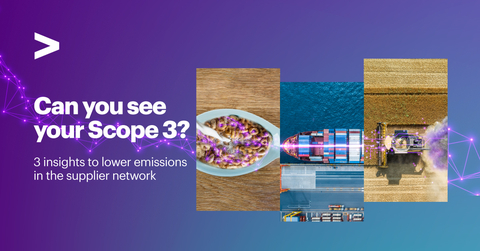Companies Can Improve Sustainability by Finding Carbon Emissions Hot Spots Across Their Supply Chains, Accenture Report Shows
Data model mapping relationships between industries and countries provides better visibility in complex supply chain networks, enabling more effective strategies to significantly reduce Scope 3 emissions by 2050

Companies need full visibility across their supplier base in order to make significant progress on net zero targets by 2050, says Accenture. (Graphic: Business Wire)
The Thought you knew the Scope 3 issues in your supply chain? Think again. report examines carbon intensive “hot spots” in supply chains across supplier tiers, identifying where greenhouse gas (GHG) emissions are significantly higher and potentially more difficult to reduce. For the report, Accenture developed a data model that uses industry- and country-level trade and emissions data to calculate the Scope 3 contribution of suppliers to their customers and create an accurate picture of the location and size of upstream GHG emissions.
“Scope 3 emissions are elusive and difficult to track in today’s complex supply chains. Many large companies don’t even know the suppliers beyond Tier 1, let alone have any sort of influence or control over them or their sustainability practices, which is why we have seen little progress in reductions to date,” said
The model Accenture created can show upstream emissions by country, industry and supplier tier – for example in German automaking revealing beyond the known suppliers in
Accenture’s analysis reveals that in most cases, if upstream emissions are a significant portion of a company’s total emissions, they tend to occur deeper in the supplier network. For example, upstream Scope 3 emissions for the aerospace and defense industry is many times the size of its Scope 1 and 2 emissions, and these upstream emissions are buried deep in its upstream supplier network – only
“Our recent research shows that only
With increased visibility into upstream Scope 3 emissions and carbon intelligence embedded into the core business, companies can make better-informed decisions about how and where to allocate resources; ensure responsible procurement throughout the organization to drive meaningful reductions; and uncover broader enterprise value by creating more efficient, resilient, cost-effective and customer-centric supply chain networks. The report recommends five key actions that all companies can take now to achieve that visibility:
- Conduct a real multi-tier emissions hot spot analysis to set targets and drive the right actions. The insights from such an analysis provide the foundation for an action plan to address the areas of most significant impact.
- Embed sustainability into category planning and supplier selection. Depending on the hot spot areas identified, a company can customize category plans, including emission-reduction strategies, to address hot spots as appropriate.
- Integrate emissions into the supply chain control tower and implement a digital twin. Control towers that centralize visibility and decision making and guiding actions with short- and long-term benefits combined with a digital twin of the supply chain generates the end-to-end visibility necessary to optimize supply chain networks across service, costs, quality, and sustainability — in real time.
- Support suppliers in their ongoing decarbonization efforts. Segmenting the supplier base can help companies tailor their engagement programs appropriately, as long as they’re also improving supplier data quality.
- Collaborate across sectors, with peers, suppliers and ecosystem partners to speed up decarbonization at scale. An intelligent platform solution to aggregate data from multiple parties and make recommendations on the most effective steps towards decarbonization is critical.
You can explore Thought you knew the Scope 3 issues in your supply chain? Think again. report in Accenture Foresight, our new thought leadership app, which provides a personalized feed of all our latest reports, case studies, blogs, interactive data charts, podcasts and more. Visit: http://www.accenture.com/foresight.
About the Research
About Accenture
Accenture is a global professional services company with leading capabilities in digital, cloud and security. Combining unmatched experience and specialized skills across more than 40 industries, we offer Strategy and Consulting, Technology and Operations services and Accenture Song — all powered by the world’s largest network of Advanced Technology and Intelligent Operations centers. Our 721,000 people deliver on the promise of technology and human ingenuity every day, serving clients in more than 120 countries. We embrace the power of change to create value and shared success for our clients, people, shareholders, partners and communities. Visit us at accenture.com.
Copyright © 2022 Accenture. All rights reserved. Accenture and its logo are trademarks of Accenture.
[1] Scope 1 emissions are direct greenhouse (GHG) emissions that occur from sources that are controlled or owned by an organization (e.g., emissions associated with fuel combustion in boilers, furnaces, vehicles).
Scope 2 emissions are indirect GHG emissions associated with the purchase of electricity, steam, heat, or cooling.
Scope 3 emissions are the result of activities from assets not owned or controlled by the reporting organization, but that the organization indirectly impacts in its value chain. Scope 3 emissions include all sources not within an organization’s scope 1 and 2 boundary. The scope 3 emissions for one organization are the scope 1 and 2 emissions of another organization.
Source:
View source version on businesswire.com: https://www.businesswire.com/news/home/20221208005008/en/
Accenture
+1 917 452 9878
alexander.aizenberg@accenture.com
Source: Accenture







